BSc 2nd Year Microbiology of Air Notes Study Material
BSc 2nd Year Microbiology of Air Notes Study Material: BSc is a three-year program in most universities. Some of the universities also offer BSc Honours. After getting enrolled for BSc, there are certain things you require the most to get better grades/marks in BSc. Out of those, there are BSc 2nd Year Study Material, BSc Sample Model Practice Mock Question Answer Papers along with BSc Previous Year Papers. At gurujistudy.com you can easily get all these study materials and notes for free. Here in this post, we are happy to provide you with BSc 2nd Year Microbiology of Air (Aeromicrobiology) Notes Study Material.
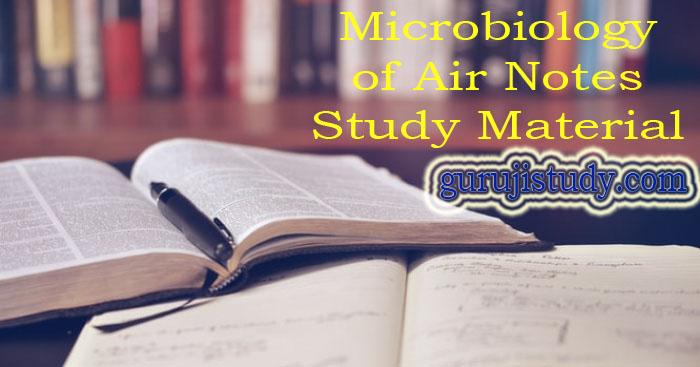
BSc 2nd Year Microbiology of Air Notes Study Material
The atmosphere as habitat is characterized by high light intensities, extreme temperature variations, low amount of organic matter, and a scarcity of available water making it a non-hospitable environment for microorganisms and generally unsuitable habitat for their growth. Nevertheless, substantial numbers of microbes are found in the lower regions of the atmosphere.

Distribution of Microbes in Air
No microbes are indigenous to the atmosphere, rather they represent allochthonous populations transported from aquatic and terrestrial habitats into the atmosphere. Microbes of air within 300-1,000 or more feet of the earth’s surface are the organisms of soil that have become attached to fragments of dried leaves, straw, or dust particles, being blown away by the Wind.
Species vary greatly in their sensitivity to a given value of relative humidity, temperature, and radiation exposures. More microbes are found in the air over land masses than far at sea. Spores of fungi, especially Alternaria, Cladosporium, Penicillium, and Aspergillus are more numerous than other forms over sea within about 400 miles of land in both polar and tropical air masses at all altitudes up to about 10,000 feet. (BSc 2nd Year Microbiology of Air Notes Study Material)
Microbes found in the air over populated land areas, below an altitude of 500 feet in clear weather include spores of Bacillus and Clostridium, ascospores of yeasts, fragments of mycelium, and spores of molds and Streptomycetaceae, pollen, protozoan cysts, algae, Micrococcus, Corynebacterium, etc. In the dust and air of schools and hospital wards or the rooms of persons suffering from infectious diseases, microbes such as tubercle bacilli, streptococci, pneumococci, and staphylococci have been demonstrated.
These respiratory bacteria are dispersed in the air in the droplets of saliva and mucus produced by coughing, sneezing, talking, and laughing. Viruses of the respiratory tract and some enteric tract are also transmitted by dust and air.
Pathogens in dust are primarily derived from objects contaminated with infectious secretions that after drying become infectious dust. Droplets are usually formed by sneezing, coughing, and talking. Each droplet consists of saliva and mucus and each may contain thousands of microbes. It has been estimated that the number of bacteria in a single sneeze may be between 10,000 and 100,000. Small droplets in a warm, dry atmosphere are dry before they reach the floor and thus quickly become droplet nuclei.
Many plant pathogens are also transported from one field to another through the air and the spread of many fungal diseases of plants can be predicted by measuring the concentration of airborne fungal spores. Human bacterial pathogens which cause important airborne diseases such as diphtheria, meningitis, pneumonia, tuberculosis, and whooping cough are described in the chapter “Bacterial Diseases of Man”.
Allergic Disorders by Air Microflora
Microflora of air is responsible for several allergic disorders. A range of airborne particles, such as pollen, fungal spores, insect debris, animal danders, mites, etc. is recognized allergens. They bring about such allergic disorders as bronchial asthma, allergic rhinitis, and atopic dermatitis. In most countries, pollen has been implicated and studied in relation to these allergic disorders. However, it has now been established that fungal spores are also equally important allergic agents. Fungal aerosols are present in much higher densities than pollen in some environments under some climatic conditions. (BSc 2nd Year Microbiology of Air Notes Study Material)
A thorough screening of diurnal, seasonal, and annual variations in both indoor as well as outdoor environments is necessary for the diagnosis and therapeutic management of these disorders. In an indoor environment, such as home and occupational surroundings, persons are exposed to fungal allergens. Fungal aeroallergens in outdoor environments originate from such sources as cereal crops, decaying vegetable matter, and organic debris. In indoor environments, damp walls, dustbins, mattresses, window frames, humidifiers, etc. are the chief source of fungal allergens. (BSc 2nd Year Microbiology of Air Notes Study Material)
Since the first report of a fungus implicated in asthma in 1726 by J. Floyer, spores of a range of fungal taxa have been shown of clinical interest and are being studied the world over for their implications in respiratory allergic reactions. Aeromycology has now become an established field of research, involving scientists of basic sciences as well as professional areas.
Several molds (species of Aspergillus, Penicillium, Mucor, Rhizopus), yeasts, and rust and smut spores are shown to be implicated in occupational allergy. On the basis of prick and intradermal skin tests, several fungi have been identified as agents of Type I hypersensitivity disorders. These include species of Alternaria, Aspergillus, Candida, Cladosporium, Curvularia, Drechslera, Epicoccum, Fusarium, Mucor, Nigrospora, Penicillium, Rhizopus, and Trichoderma. (BSc 2nd Year Microbiology of Air Notes Study Material)
Besides skin tests, fungal allergy is diagnosed by the use of inhalation challenge, RAST, ELISA, immunodor, and immunoblot techniques. These immunological techniques have proved to be useful in the diagnosis and treatment of pollen and fungal allergic disorders.
India is not only a sub-continent of rich biodiversity but also has various geo-climatic zones. In a given zone there are experienced marked seasonal fluctuations in temperature and relative humidity. Consequently, the sources and nature of aeroallergens differ in different areas and in different seasons of a given area. For instance, pollen becomes important inhalant allergens chiefly in two seasons- (i) months of September- November, dominated by pollens of weeds and grasses, and (ii) months of March-May, dominated by pollens of trees.
Collection and Enumeration of Aeroallergens
Various methods have been developed to collect and quantify pollen and fungal aeroallergens. Durham’s gravitational sampler, developed in the 1940s is the simplest and most commonly used sampler even today in some parts of the world including India. It is a simple device consisting of two metallic discs separated by three struts. (BSc 2nd Year Microbiology of Air Notes Study Material)
The microscope slide coated with adhesive is mounted an inch above the center of the lower disc, upper disc acting as a rain shield. The slides are exposed for 24 hr. The sampler can be used for qualitative analysis of various kinds of spores, particularly larger ones, giving a rough idea of the seasonal trend. (BSc 2nd Year Microbiology of Air Notes Study Material)
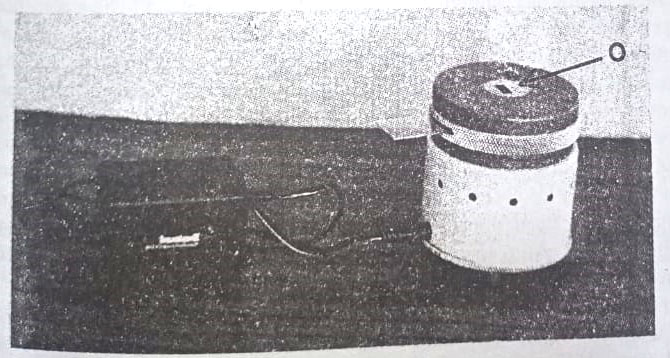
However, some sophisticated samplers based on impaction and suction devices (battery- as well as power-operated) have now been developed. These provide more accurate data on species composition as well as the density of aeroallergens.
Based on a suction device with a definite amount of air sucked in and impacting the bioparticles on the adhesive material on the sampler is the most acceptable device world over. The Burkard volumetric traps and Rotarod aeroallergen models are such samplers. Burkard personal slide sampler (suction), battery-operated, suitable for an indoor environment is 10 cm high having a rectangular orifice at the top.
The macrolide is coated with glycerine jelly. The sampler sucks air at a flow rate of 10 l/minute through the orifice. The particles get impacted on the slide forming a band. The slide is mounted and scanned. Burkard’s personal Petri dish sampler is similar to the slide sampler except that it has a stage to hold a Petri dish and a sieve to cover it. The orifice is circular. Petri dishes containing suitable growth medium become exposed to a definite volume of air through the sieve onto the Petri dishes. These two samplers are suitable for indoor environments. (BSc 2nd Year Microbiology of Air Notes Study Material)
Burkard’s continuous 7-day trap (continuous impaction) uses a glycerine jelly-coated tape mounted on a rotating drum. The drum is connected to a timer and rotates at a constant speed. Tape exposed for a week is cut into seven strips, one for each day, mounted on a slide in glycerine jelly, and scanned. Each strip can also be divided into 24 vertical bands, each band representing a particular hour of the day.
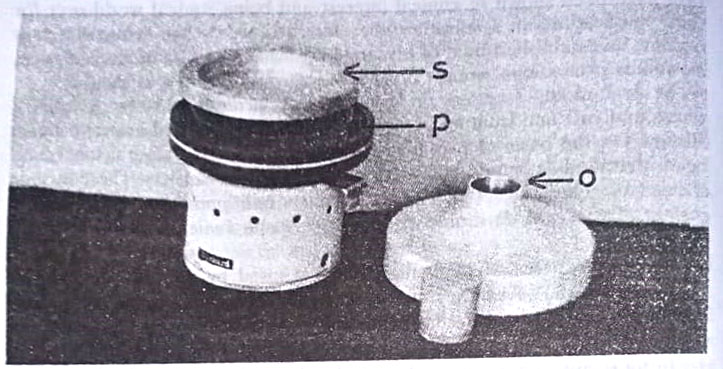
The most accurate samplers to be used these days are the following two samplers.
[1] Rotarod aeroallergen intermittent sampler
This sampler has an intermittent rotating impactor, is power-operated, and is ideal for both indoor and outdoor studies. It is a lightweight, portable sampler. It has an arm that holds two cubical rods coated with silicon grease. Unexposed rods remain folded. The arm has a shield at top for protection from rains. Exposure time can be regulated. The rods are mounted on a grooved slide in a basic Fuschin stain and scanned. (BSc 2nd Year Microbiology of Air Notes Study Material)
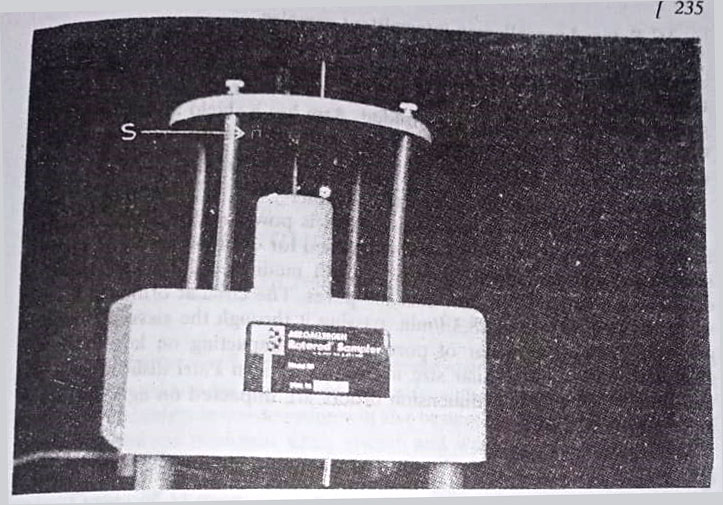
[II] Andersen six-stage volumetric sampler
This sampler based on suction is power-operated and ideal for indoor environments, though can also be used for outdoor studies. There are six Petri dishes containing suitable growth medium, kept under sieves of different pore sizes. Each sieve has 400 pores. The circular orifice at the top sucks air at a flow rate of 28.3 l/min. passing it through the sieve arranged in a gradually decreasing order of pore size.
Air impacting the last Petri dish goes out. Particles of similar size impact a given Petri dish only. In this way, spores/pollens of six dimension orders are impacted on the agar surface of individual Petri dishes. (BSc 2nd Year Microbiology of Air Notes Study Material)
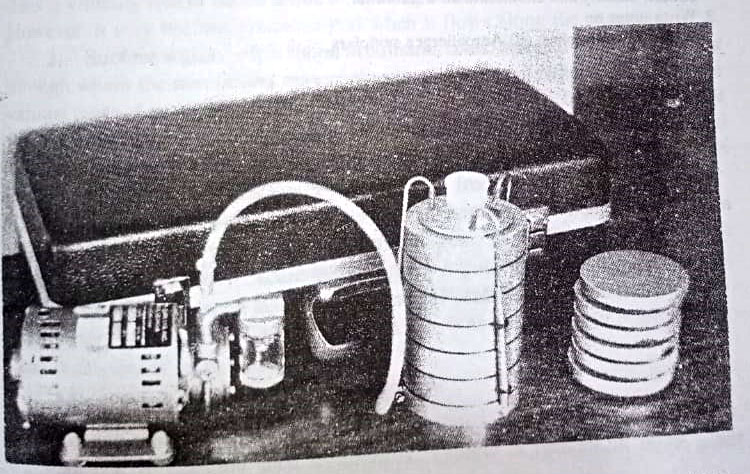
BSc 2nd Year Microbiology of Air Notes Study Material
BSc 2nd Year Sample Model Practice Mock Test Question Answer Papers